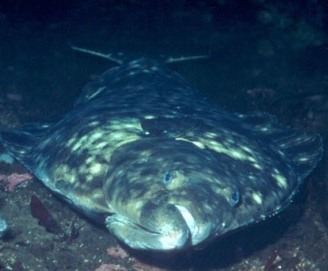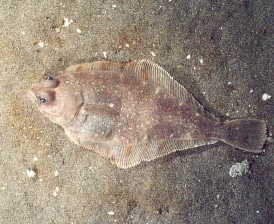Explanation of the Classification
|
Domain |
Eukarya |
|
Kingdom |
Animalia |
|
Phylum |
Chordata |
|
Class |
Actinopterygii |
|
Order |
Pleuronectiformes |
|
Family |
Pleuronectidae |
|
Genus |
Hippoglossus |
|
Species |
Hippoglossus |
The Pacific halibut is classified in the domain Eukarya due to its eukaryotic cell structure and the kingdom Amimalia because of its multicellular make-up lacking cell walls, heterotrophic nature, motility, and complex tissue structure derived from an embryo that underwent a blastula stage. It belongs to the phylum Chordata because it possesses a notochord, a dorsal nerve chord, pharyngeal pouches, an endostyle, and a postanal tail, all at some point in its life. Like many of the fishes you are probably familiar with, halibut have fins that consist of bony spines linked together with webs of skin; These "fin rays" place them in the class Actinopterygii. Within this grouping are the flatfish from the order Pleuronectiformes. These fish are distinct due to their nature to swim on their side and peer through two protruding eyes located on one side of their body. More specifically yet, the halibut is classified within the family Pleuronectidae because its two eyes lie on the right side of its body. The genus Hippoglossus contains the largest halibuts. They are classified together based on their lengthened body and defined caudal tail in comparison to other flatfish. Only two species exist within this genus: H. hippoglossus, the Atlantic halibut, and H. stenolepis, the Pacific halibut. Besides their regional difference, few other deviations exist between the two. The Pacific halibut has a slightly narrower scale and a larger pectoral fin.

Check out this link to view an abbreviated phylogenic tree showing that the halibut is included in the class Actinopterygii and depicting where it fits into the order Pleuronectiformes; the link will open as a .pdf. This cladistic tree is based on the mitochondrial 16s rDNA sequence.
We are very familiar with some of the Pacific halibut's more distant relatives from the class Actinopterygii such as the Atlantic Cod, the Daisy Parrotfish, the Northern Pike, and the Largemouth Bass. The halibut is related to these fish because they all possesses "fin rays" - boney spines that hold the fishes' fins erect. To find some closer relatives to the halibut, we must look within the class Actinopterygii to the order of fish called Pleuronectiformes (the flatfish). All fish with this order (over 400 species) exhibit distinctive lateral flattening of their bodies. In the phylogenic tree I linked to above, I included the five families that express the greatest morphological similarities to the halibut: Achiridae, Scophthalmida, Soleida, Cynoglossida, and Paralichthyidae. The family Paralichthyidae includes the closest relatives to the Pacific halibut. Only slight differences exist in this family of flatfish including larger teeth, a smaller body, and the migration of the right eye to the left side of the body instead of the migration of the left eye to the right side of the body as found in the Pacific halibut's family, Pleuronectidae. The California halibut and the Pacific sanddab, both members of the family Paralichthyidae, are close relatives to Hippoglossus stenolepis. The California halibut (Paralichthys californicus), pictured to the lower left, is significantly smaller than the Pacific halibut but exhibits very similar behavior and expresses resembling morphology. Likewise, the Pacific sanddab (Citharichthys sordidus), pictured to the lower right, is smaller and slightly lighter in color than halibut, but has a very similar lifestyle.
The
Atlantic halibut, the only other species within the genus
Hippoglossus, is most closely related to the Pacific
halibut. Only slight differences exist between the
two, such as the slightly narrower scale and differing pectoral
fin length of the Pacific halibut. The only substantial
difference between the two is their habitat. As their names
imply, the Atlantic halibut resides between North America and
Europe, while the Pacific halibut is found nearly on the other
side of the globe, between North America and Asia. Go on to
read more about the Pacific halibut's
habitat.

